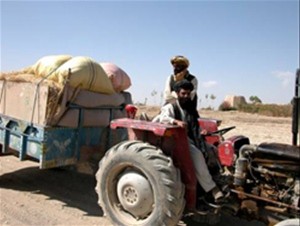
Abdul Aquil, at the wheel of his tractor, brings crops to market on the Jaghatu to Rashidan road. "The road increases trade between the villages,” says Abdul.
Matt Herrick
Improving major road systems through education, training and technology
1 DECEMBER 2003 | JAGHATU, GHAZNI PROVINCE
Challenge
Recent floods have put deep scars in the land along the roads in Afghanistan. Large stones and huge gashes - two or three feet deep - run from the nearby hills through the farmland, tracing the flood’s path. Compounded with the devastation of war, development experts also cite erosion and lack of quality workmanship as major factors for Afghanistan’s poor road system. In addition, the community’s duty to provide regular maintenance to the roads have been overlooked.
Initiative
USAID provided funding to train local NGOs in the basics of quality secondary road construction. The six-week program provided classroom and on-site lessons. Afghan staff learned to crown and compact roads to allow for proper drainage, to dig side ditches, and use culverts to capture the runoff. They received training on how to use small equipment, such as compactors, that reduce traditional labor-intensive work.
In addition, experienced engineers shared design standards, lessons in logistics, and how to select choice road materials. NGOs then put their training to work in the rebuilding of the roads while providing significant outreach to the villages on its maintenance.
Results
Along this smooth section of street, professionalism and education provided by USAID’s program have replaced the old standard way of building roads. According to 40-year-old Sherenjan, a sharecropper who owns a potato patch, “It is the road that brings the buyers and gives these men work. They did not come before because you could not use the roads with a large truck. It could tip over.”
The road carries an estimated $14 million in trade per year and opens pathways to business, medical services, and travel. Taxi services to Gazni, a major market center only 45 minutes southwest, have lowered fares because of improved road conditions. Improved access to clinics and hospitals in Ghazni is another invaluable result of road construction.







Comment
Make a general inquiry or suggest an improvement.